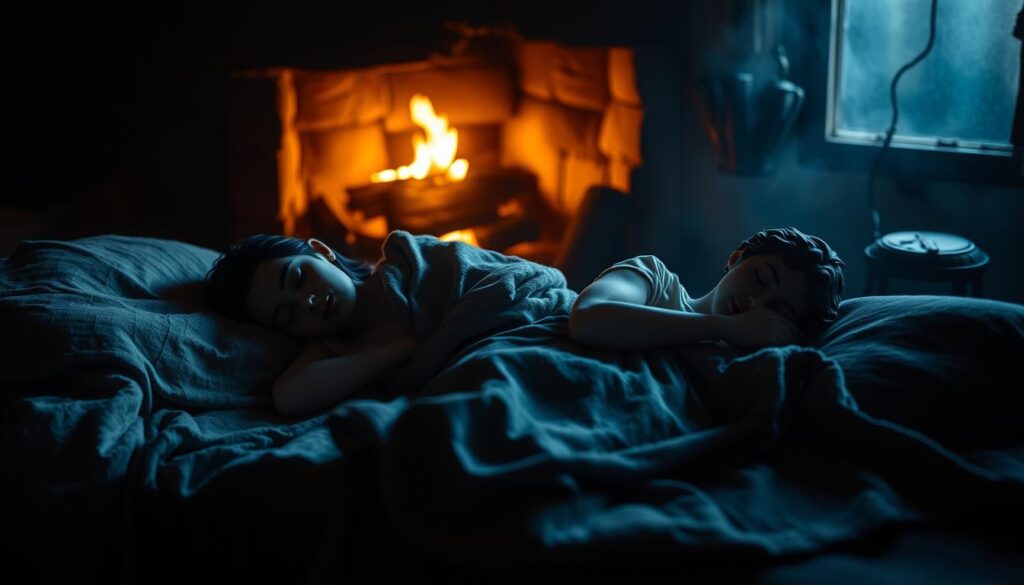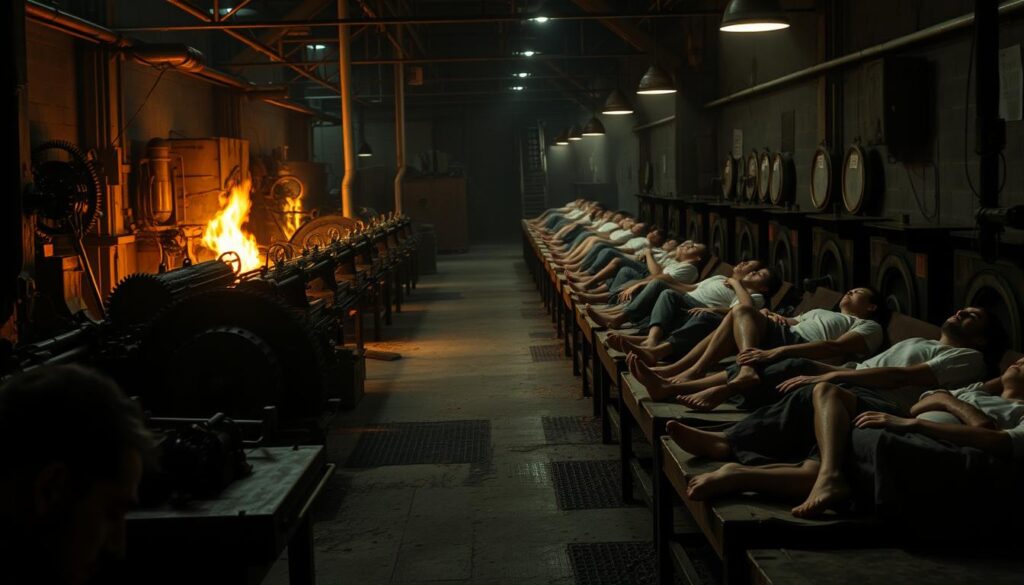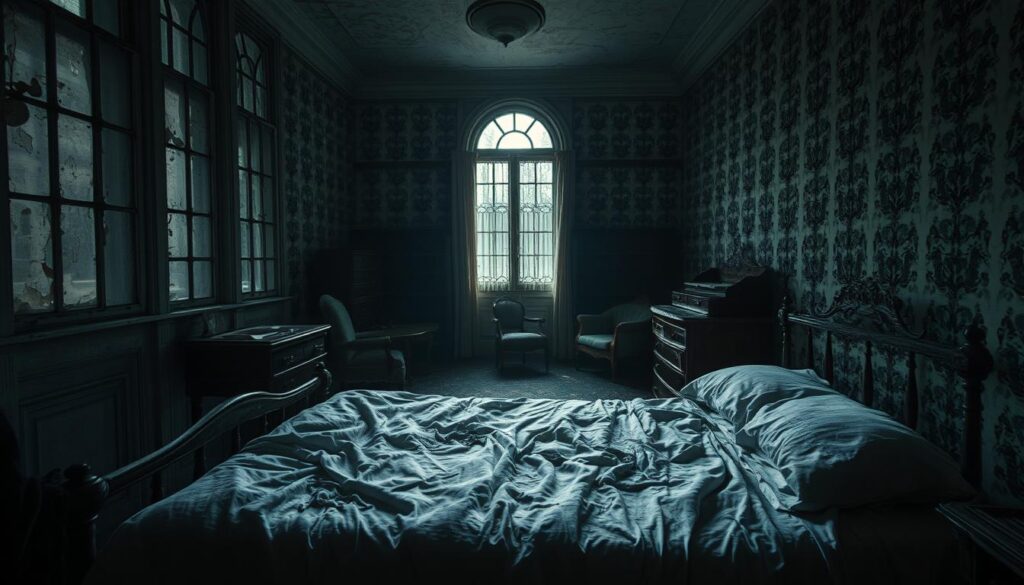Research shows ancient people slept in two parts, with a wakeful break in between. This pattern, known as biphasic sleep, is not new. It has been seen in many cultures. They slept twice a night, with a break, now called segmented or biphasic sleep.

We will look into biphasic sleep’s history and how ancient people slept twice a night. This topic is interesting, and knowing its history helps us understand our sleep better. In medieval Europe, people followed biphasic sleep. They went to bed early, woke up, and then slept again.
Introduction to Biphasic Sleep
Ancient people slept twice a night, as history shows. Biphasic sleep is not a new concept. It has been seen in cultures worldwide. By studying biphasic sleep’s history, we learn more about our sleep patterns and how they’ve changed.
Key Takeaways
- Ancient people practiced biphasic sleep, sleeping twice a night with a period of wakefulness in between.
- Biphasic sleep was common in medieval Europe, where people would go to bed early and wake up for a few hours before going back to bed.
- Segmented sleep is still observed in some parts of the world today, with people sleeping in two segments.
- Understanding the history of biphasic sleep can provide valuable insights into our sleep patterns.
- Ancient people slept twice a night, following a unique sleep pattern that is now referred to as biphasic sleep.
- Biphasic sleep has been documented in various historical records, providing evidence of its existence in ancient cultures.
The Lost Art of Segmented Sleep
Ancient civilizations like the Greeks and Romans used a sleep pattern called segmented sleep. This pattern involves sleeping in two parts with a wakeful period in between. The medieval sleep pattern is a prime example, where people would sleep early, wake up, and then sleep again.
This pattern wasn’t just for the medieval times. It was also used by other ancient cultures. Key features of segmented sleep include:
- Sleeping in two distinct segments, with a period of wakefulness in between
- Going to bed early, typically around sunset
- Waking up for a few hours in the middle of the night, often for prayer, meditation, or other activities
- Going back to bed for a second sleep period, often until sunrise
Studies reveal that segmented sleep was widespread in ancient times. It was believed to enhance sleep quality, mental clarity, and productivity. The medieval sleep pattern is just one example of how segmented sleep was used in the past. It remains a fascinating topic for researchers and historians today.
How Ancient People Slept Twice a Night – A Deeper Look
Ancient people slept twice a night because they didn’t have artificial lights. This made them sleep in sync with the sun and moon. This pattern helped them rest and get ready for the next day.
Research shows this sleep pattern was key for their health and well-being.
Some key aspects of this sleep pattern include:
- Early bedtime: People would go to bed early, soon after sunset.
- Mid-night wakefulness: People would wake up for a few hours in the middle of the night, often using this time for relaxation or personal activities.
- Second sleep: After the mid-night wakefulness, people would go back to bed for a second sleep period, which would last until morning.
This sleep pattern greatly affected their daily lives. It influenced their work, social interactions, and health.
Learning about ancient sleep patterns helps us understand the importance of sleep. It shows us the value of following our natural sleep cycles, not just artificial lights.
The Science Behind Biphasic Sleep
Studies show that biphasic sleep is controlled by our body’s circadian rhythms. These rhythms are managed by the suprachiasmatic nucleus (SCN). The SCN uses light and darkness to keep our body’s processes in sync with day and night.
This natural process is also influenced by hormonal influences. Hormones like melatonin and cortisol help regulate our sleep. They play a key role in how we sleep in two parts.
Segmented sleep cycles offer many benefits. Some of these include:
- Improved memory consolidation
- Enhanced creativity
- Better overall health and well-being
Learning about biphasic sleep helps us see its benefits. It shows us how to align our sleep with our body’s needs. By following our natural circadian rhythms and hormonal influences, we can sleep better.
Exploring biphasic sleep science helps us understand our bodies better. It shows us how to improve our sleep for better health. This knowledge lets us make smart choices about our sleep, leading to a better life.
Historical Evidence from Different Cultures
Research shows that biphasic sleep was common worldwide. It wasn’t just medieval Europe that practiced it. Cultures like the Japanese, Chinese, and Africans also valued rest, using biphasic sleep in their daily lives.
In Japan, people took a short nap after lunch and then slept longer at night. In China, the “siesta” was a common practice. People rested in the early afternoon before going back to their day.
Biphasic sleep is seen in many aspects of these cultures. This includes their literature, art, and daily routines. By looking at historical evidence from different cultures, we can understand biphasic sleep’s importance and its effect on our health.
Some important findings from historical evidence are:
- Biphasic sleep was practiced by various cultures around the world
- It was valued for its restorative and rejuvenating properties
- It was often incorporated into daily routines, such as after lunch or before bedtime
By studying historical evidence from different cultures, we can learn about biphasic sleep’s benefits and drawbacks. We can also see how it can be used in our modern lives.
Night Activities Between Sleep Periods
People did many things at night to feel better. They relaxed, thought deeply, and connected with others. Studies show that prayer and meditation were big parts of this. They helped clear minds and grow spiritually.
Some common night activities included:
- Social interactions, such as visiting with family and friends
- Household tasks, such as cleaning and organizing
- Personal activities, such as reading and writing
These activities were key for a good balance in life. Prayer and meditation cut down stress and boosted mental health. Social interactions also built strong bonds and a sense of community. This is vital for our emotional and mental health.
The Industrial Revolution’s Impact on Sleep Patterns
The industrial revolution changed sleep patterns a lot. Artificial lighting and industrial growth led to new sleep habits. People moved from sleeping in two parts to one long sleep period.
Studies show the industrial revolution really affected sleep patterns. Moving to cities for work meant more artificial light. This hurt sleep quality and led to more sleep problems.
Several factors changed sleep patterns during the industrial revolution:
- More artificial lighting
- New work schedules
- Less physical activity

The industrial revolution still affects sleep patterns today. Many face sleep disorders and poor sleep. Knowing how sleep has changed can help us improve our health.
Modern Research on Biphasic Sleep
Recent studies have uncovered the good and bad sides of biphasic sleep. Contemporary sleep studies reveal it can boost brain function, lower stress, and up productivity. Modern research also points to its health implications, like better mental health and a lower risk of chronic diseases.
Some key findings from contemporary sleep studies are:
- Improved cognitive function and memory consolidation
- Reduced stress and anxiety
- Increased productivity and creativity
But, it’s important to note the possible health implications of biphasic sleep. It might mess with our natural sleep cycles. As modern research keeps finding out more, it’s key to think about both sides to choose the best sleep pattern for us.
Why We Abandoned Two-Phase Sleep
The move away from two-phase sleep was a slow change. Industrialization and urban growth were key factors. People’s sleep habits changed to fit modern life demands.
The old biphasic sleep pattern, with two sleep segments and a wake period, was replaced. Now, most sleep in one long night segment. This change helped people adjust to working long hours in factories.
As cities expanded, so did the need for artificial lights and new tech. These changes disrupted natural sleep patterns. The new single-night sleep pattern fit better with modern life demands.
Some key factors that led to the shift include:
- Increased urbanization and the growth of cities
- The rise of industrialization and the need for factory workers
- The development of artificial lighting and other technological advancements

Today, most sleep in one long night segment. But research suggests this might not be best for everyone. Some might still benefit from two sleep segments and a wake period.
More research is needed to understand sleep patterns’ health effects. It could help find if returning to two-phase sleep is good for some.
Could Segmented Sleep Work Today?
Exploring segmented sleep makes us think if it fits today’s world. With flexible work and the gig economy, we seek better time management. Segmented sleep could help, fitting our personal needs for rest and energy.
Studies show segmented sleep works in today’s world, boosting our health and happiness. By adjusting our sleep, we can live better. Benefits include sharper minds, more energy, and creativity.
Benefits of Segmented Sleep
- Improved cognitive function
- Increased energy levels
- Enhanced creativity
Thinking about practical considerations for segmented sleep is key. We need to adjust our daily routines and environments. This way, we can enjoy the benefits of segmented sleep and feel better.
Whether segmented sleep works today depends on our ability to adapt it. Seeing segmented sleep as a good option is a first step. With planning and practical considerations, we can make it work and feel its benefits.
Cultural Remnants of Biphasic Sleep
Studies show that cultural remnants of biphasic sleep exist globally. The Spanish siesta and Italian riposo are examples. These show how biphasic sleep continues to shape our daily routines.
Here are some examples of cultural remnants of biphasic sleep:
- Sierra Leone’s early afternoon break for rest and socializing
- India’s post-lunch nap time
- China’s waking period for rest and meditation
These remnants show that biphasic sleep is still valued worldwide. They remind us of the need for rest and relaxation every day.
In summary, the study of biphasic sleep’s cultural remnants is intriguing. It shows the variety of sleep practices globally. By looking into these remnants, we learn more about the value of rest and relaxation in our lives.
Conclusion: Lessons from Our Ancestors’ Sleep Habits
Our journey into biphasic sleep shows us much from our ancestors. Even though we live in a 24/7 world, their sleep habits still teach us a lot. They knew how to rest and relax in a way that’s still relevant today.
Learning about our circadian rhythms and biphasic sleep can help us live better. We might take short naps or make time for quiet reflection. These ancient practices can improve our health and happiness.
The story of biphasic sleep shows our ability to adapt and thrive. As we grow and change, remembering our ancestors’ wisdom is key. It helps us build a better, more balanced life for the future.
FAQ
What is biphasic sleep?
Biphasic sleep, also known as segmented sleep, is when people sleep in two parts. They wake up in between.
When did ancient people practice biphasic sleep?
In medieval Europe, biphasic sleep was common. People would sleep early, wake up, and then sleep again.
What were the reasons for biphasic sleep in ancient times?
Ancient people slept twice a night because of no artificial light. Smartphones, TVs, and computers didn’t exist. So, their sleep was ruled by the sun and moon.
How was biphasic sleep practiced in different cultures?
Biphasic sleep wasn’t just for medieval Europe. Cultures like the Japanese, Chinese, and African ones also valued rest. They practiced this sleep pattern too.
What activities did people engage in during the wakefulness period?
During wakefulness, people did many things. They prayed, meditated, socialized, and did household chores.
How did the industrial revolution impact sleep patterns?
The industrial revolution changed sleep patterns. It moved from biphasic to monophasic sleep. Now, people sleep for one long period.
What are the benefits of biphasic sleep?
Studies show biphasic sleep can boost brain function, lower stress, and increase productivity. But, it can also mess with our natural sleep cycles.
Could segmented sleep work today?
Biphasic sleep might seem old-fashioned, but it can fit into today’s world. Especially with the gig economy and flexible work hours.
What cultural remnants of biphasic sleep can still be seen today?
Today, we still see the value of rest and relaxation. The Spanish siesta and Italian riposo are examples. They show how biphasic sleep’s spirit lives on.
